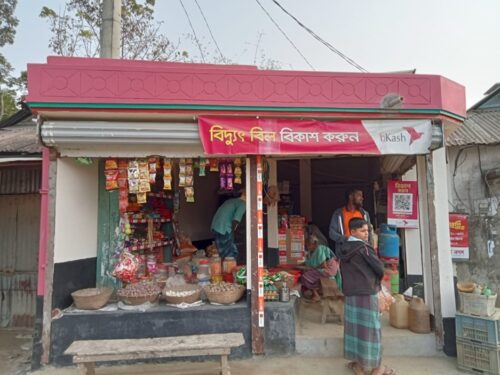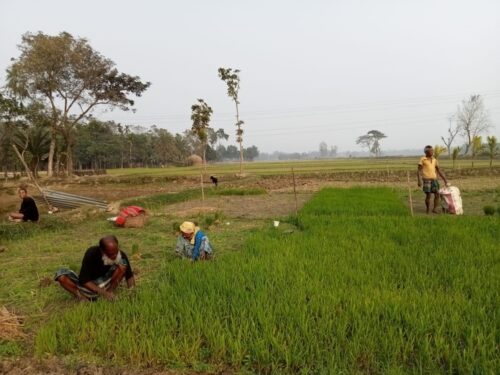By Deepa Joshi (IWMI), Farhana Sarker (CMED Health) and Mariangel Garcia Andarcia (IWMI)

A recent study conducted by the CGIAR Initiative on Digital Innovation sheds light on the digital divide in the agri-food sector, showcasing its ability to bolster productivity and resilience. However, advances in digital innovations happen in the face of glaring disparities, particularly among marginalized groups and women, exposing stark digital divides and exclusion barriers.
This comprehensive research underscores the urgent need for a nuanced, inclusive approach to digitalize agriculture, emphasizing that true progress necessitates not just technological advancement but a concerted effort to build digital capacity of marginalized groups and reduce the gender digital gap.
Digital innovations to boost Bangladesh’s agrarian economy
Bangladesh is ranked as the fastest growing economy in the Asia-Pacific region. This small, densely populated deltaic country has managed to steadily increase agricultural productivity in the last two decades (1999-2019). However, more recently, the agrarian economy’s contribution to the country’s GDP is reported to be held back by challenges in productivity, competitiveness, and innovation impacted by increasing climate risks and challenges.
Agriculture is the lifeline of the formal and informal rural economy in Bangladesh. More than 70 percent of Bangladesh’s population lives in rural areas. Nearly half of all of Bangladesh’s workers and two-thirds in rural areas are directly employed by agriculture, and about 87 percent of rural households rely on agriculture for at least part of their income. There are worrying reports that climate risks aggravate widespread landlessness, chronic poverty and persisting food insecurity, especially in low-income households.
National and global experts argue that digitalization of agriculture holds the promise to reenergize the recently low performing agricultural economy in Bangladesh. In the face of high climate risks, cutting edge technology and data can address access to finance, weather/soil and inputs information, market intelligence, and capacity for data-driven, smart agriculture.

Digital Inequities at the heart of agrifood systems: Unveiling disparities in Bangladesh’s agricultural landscape
A review of secondary data and primary research undertaken in 2023 through the CGIAR Initiative on Digital Innovations shows that without targeted attention to addressing digital divides and exclusions at the bottom rungs of food value chains amongst marginalized smallholders especially women, digital innovations will further the already prominent inequities in agrifood systems.
Recent initiatives by the government and the World Bank have resolved the basic challenge to digitization. Our data for the report reveals several pivotal points regarding digital access in Bangladesh:
- Electricity Accessibility:
- Bangladesh exhibits a commendable 100% coverage of electricity among households, with 97.76% actively using it at home.
- Internet Accessibility Challenges:
- Access to the internet remains a concern, with only 12.75% of households having internet connectivity.
- Disparities exist across regions:
- Barisal region boasts the highest Wi-Fi connectivity and internet use at 17.25%.
- Mymensingh, notably among the Garo and Hajong ethnic minorities, displays the lowest connectivity, standing at 4.9%.
Despite progress, gender disparities persist.

Gendered complexities of the digital divide
In a comprehensive survey covering three divisions in Bangladesh—Barishal, Kurigram, and Mymensingh—key findings underscore concerning digital disparities, particularly the gender gap in mobile internet use:
- Gender Disparity in Mobile Internet Use: Only 19% of women compared to 36% of men reported access to and use of mobile data, echoing a pronounced gender gap in mobile internet usage prevalent in the country (GSMA 2022).
- Access Channels for Information: While 94.36% of male respondents used mobile phones to access information, a similar percentage of women (94.47%) relied on family members and friends for information.
- Device Ownership: Despite widespread access to feature phones (90.7% overall), ownership and usage of smartphones were notably low at 31.52% overall, with 14% of women reporting a lack of access and usage of smartphones.
- Digital Engagement Among Older Smallholder Farmers: Interestingly, male smallholder farmers above 50 years, irrespective of phone and mobile data ownership, showed limited engagement with digital agri-services.
- Youth and Internet Usage: Internet access was higher among youth (51.49%), but its usage primarily focused on social and entertainment purposes. A substantial digital gender gap was evident, with 62.88% of male youth having regular internet access compared to 34.10% of female youth.
These findings highlight a concerning pattern of digital exclusion, especially among women and older smallholder farmers, emphasizing the need for targeted interventions to bridge these disparities in digital access and use in Bangladesh’s agrarian landscape.

Challenges faced by women in rural Bangladesh: Digital access and literacy barriers
The survey findings from Kurigram District and other locations in Bangladesh underscore critical challenges faced by women regarding mobile phone access and digital literacy:
- Feature Phone Ownership: While 60.78% of women in Kurigram owned feature phones, only a small fraction (11.96%) reported occasional access to a smartphone, reflecting limited engagement with advanced mobile technology.
- Social and Cultural Constraints: Discussions revealed that women encounter multiple social and cultural barriers, including the pressure of domestic responsibilities and productive work, hindering their ability to invest time in acquiring digital literacy and utilizing digital services effectively.
- Reliance on Male Family Members: Incidences of cyber violence and harassment have created a reliance among women on male family members for accessing and using digital services, indicating safety concerns in digital spaces.
- Limited Training and Digital Expertise: Merely 2.30% of female respondents received training on internet-based applications. Among this group, only 9.45% felt confident in independently using digital devices, significantly lower compared to 23.52% of men with reported digital expertise.

The worrying key finding in our study was that only 7% of smallholder male farmers, and not a single woman respondent reported the use of digital devices for getting agriculture input or advice-related information – Dr. Farhana Sarkar
This was not surprising. Analysing contemporary, in-use digital agri-services and initiatives, we found that only a few innovations are needs based and designed to cater to marginalized smallholders, women, or youth. In a workshop conducted in Dhaka with public and private agri-entrepreneurs we noted a lack of awareness on the complexities of the gendered gaps discussed above. Interestingly, digital agri-innovations are yet to tap the largest group with access to digital services – rural youth.
Other digitization barriers
In Bangladesh, as elsewhere, we see the trend of digitalization innovations and digital knowledge flows amongst large and financially secure farmers. Our research showed that smallholder farmers are most likely to own and use a simple feature phone due to the significantly higher costs of smart devices and the internet services, as well as due to the lack of capacity and expertise. But smallholder farmers comprise around 85% of the total agriculture labor force in Bangladesh and there are reports that the ‘move away from predominantly agriculture employment to increased non-farm employment’ indicates ‘a clear trend towards the feminization of agriculture labor.’
The provided data indicates significant hurdles faced by respondents, particularly women, in embracing digital technology:
- Cost Restraints:
– About 70.64% of respondents, predominantly female farmers (80%+), highlighted the prohibitive cost of purchasing digital devices and internet services as a primary constraint.
– The gender gap in affordability is stark, with over 80% of female farmers citing financial limitations, compared to 63.36% of male farmers.
Social Bias and Cyber Risks:
– A prevailing social bias obstructs women’s access to and utilization of digital devices, with 50% of women in Bangladesh having faced cyber violence, harassment, or bullying.
– These societal challenges significantly impede women from engaging as agri-entrepreneurs, dissuading young women due to both inadequate skills and the fear of navigating digital risks.
The findings underscore the dual challenges of economic barriers and societal biases that obstruct women from leveraging digital tools effectively. Addressing these systemic issues is crucial to foster an environment where women can harness digital technology confidently and participate equitably as agri-entrepreneurs in Bangladesh.
Little progress in reducing the gender digital divide.
The 2023 Mobile Gender Gap Report (GSMA 2023) points out that in an increasingly digitized world, there are worrying trends that digital gender gaps are not reducing proportionately.
Almost two-thirds of the 900 million women still not using mobile internet live in South Asia and Sub-Saharan Africa.
Reversing this trend requires not just adopting a more inclusive, human-centered approach to digitalizing agriculture, but also addressing systemic, structural gender disparities. In Bangladesh, some of these challenges include enabling e-literacy for women who also face challenges of basic illiteracy; tackling social norms that disallow women’s access to mobile devices and internet services; and tackling biases that shape beliefs that digital knowhow is not relevant for women.
It is not surprising that in a survey of 6500 rural households in Bangladesh, 63% of the households identified the male head of household as the most digitally enabled person.

Our research shows that the significant advances made by the Government of Bangladesh and other actors to digitalize agriculture are not coherently focused on the complexities of the digital gender divide. Without attention to the heterogeneity and diversity of the end-users, these well-intentioned interventions will widen gaps in agency and capability, decision-making power, and digital literacy of those “still left behind.”
The research underscores the urgency for a targeted approach in digitalizing agriculture, one that acknowledges the diversity and nuances of end-users. Without a concerted effort to empower marginalized groups—especially women—and bridge the digital gender gap, well-intentioned interventions risk exacerbating disparities, leaving many behind in the digital revolution.
Bangladesh’s journey toward a thriving agrarian economy demands a holistic approach—one that champions digital inclusion, empowers the marginalized, and redefines the role of technology in fostering an equitable, resilient agricultural sector.
The CGIAR Digital Innovation is working towards a solution, A research collaboration, led by the International Water Management Institute, has proposed a holistic framework as a tool featuring a list of standard dimensions and indicators of digital inclusivity to fill these gaps. The specifics and underpinning indicators that make up this framework, as well as an innovative digital inclusivity index has just been submitted by the authors for peer review.
Acknowledgments
The team would like to thank all the respondents from the different research locations for their contribution to this research endeavor. The team would also like to thank relevant staff from the Department of Agricultural Extension (DAE), Ministry of Agriculture (MoA), Ministry of Water Resources (MoWR), Ministry of Land (MoL), Access to Information (a2i), Bangladesh Institute of ICT in Development (BIID), Syngenta Foundation, Light Castle Partner (LCP), Cordaid and Bangladesh Agriculture University (BAU) for valuable suggestions and inputs during the research process and during the stakeholder workshop. The team is grateful to digital ecosystem stakeholders of agrifood systems in Bangladesh for participating in the workshop organized by the team and for their valuable feedback. The information and data provided in this report are based on secondary and primary research conducted by the team, who remain solely responsible for any technical or other errors in this report.
Further reading:
Inclusion in agri-food systems in Bangladesh: the digital innovation and transformation initiative
Data-driven breakthroughs and the future of agriculture at the CGIAR Digital Innovation Workshop
The digital divide for food, land and water systems: What is it and what can be done?

